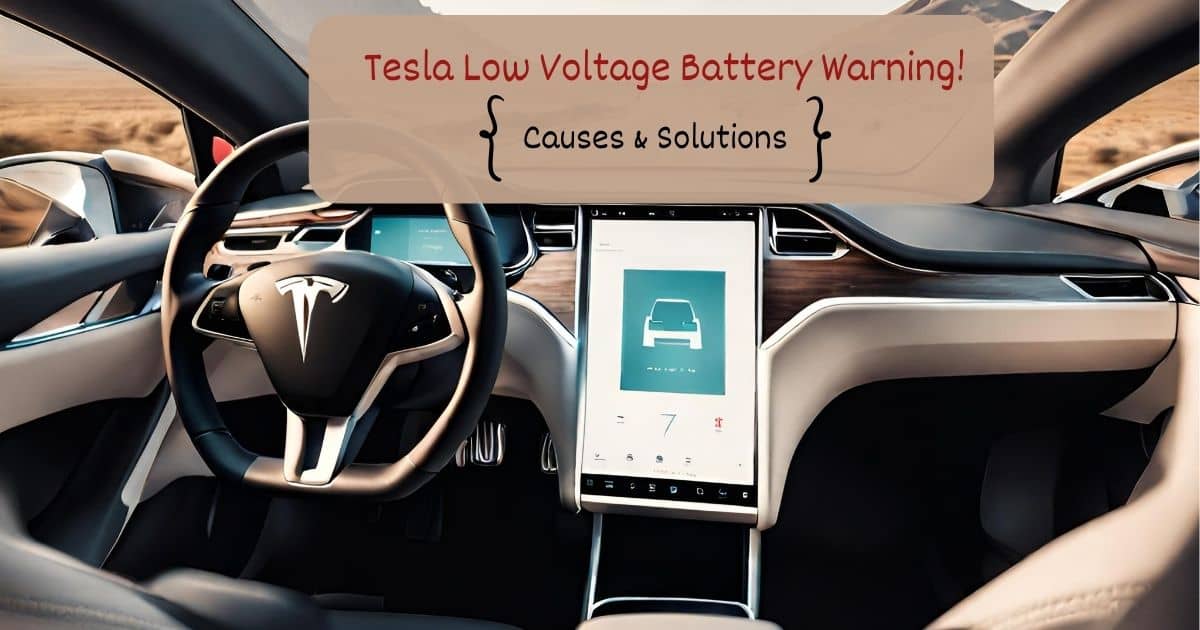The Tesla vehicle’s system has access to many car functions and displays a warning sign to the driver of an issue. One of them is a low voltage battery warning displayed on the touch screen.
But what causes Tesla’s low-voltage battery warning? This warning tells of a weak 12V battery, which powers various components in the car. The causes include aging, battery draining, or extreme temperatures. The solution is usually to recharge and replace the battery as soon as possible. Also, avoid exposing the vehicle to extreme temperatures.
Read on to learn more about the low voltage battery warning, including causes, risks, and the steps to change.
What Is Tesla’s Low Voltage Battery Warning?
Tesla’s low-voltage battery warning is a warning message displayed on the bottom of your car’s touchscreen. This warning usually consists of a yellow warning triangle with a warning message for you to schedule service to replace it.
This warning message has been reported in most models, including Tesla Model S and X. This warning message tells that the 12V battery is weak and requires replacement soon. But what is the 12V battery in the Tesla?
Tesla 12V Battery
Tesla cars feature a 12V battery, just like traditional internal combustion engine vehicles. This battery is usually a lead-acid, which uses lead and sulphuric acid. However, newer models have Lithium Ion batteries, which are lighter and have quicker charging rates.
The battery in the Tesla serves almost similar purposes as that in the combustion engine. It powers various electrical components in the car when the car is off. These components include the following.
- Lights
- Window motors
- Wipers
- Locks
- Entertainment system
- Power Liftgate
- Anti-lock Braking System
What Causes Tesla’s Low Voltage Battery Warning?

As mentioned earlier, the warning tells you the 12V battery is weak and may fail to provide sufficient power when needed. These batteries weaken as they age since most traditional lead acid batteries only last 3-5 years.
Besides the weak battery, the low voltage battery warning may be due to the following reasons.
1. Drained Power
A drained 12V battery can also cause the Low voltage warning to display on the infotainment touchscreen. This scenario is more likely when you leave various accessories running when the vehicle is parked.
These accessories can drain the battery’s power if left for long. The result is a low-voltage battery, which triggers the low-voltage warning.
2. Faulty Charging System
Tesla cars feature a converter that draws power from the Lithium Ion battery pack that powers the vehicle, charging the 12V battery. If there’s an issue with the converter, it will not charge the battery fully, leading to low power and triggering the low-voltage battery warning.
3. Extreme Temperatures
Extreme cold or hot temperatures can also be behind Tesla’s low-voltage battery warning. During extremely cold temperatures, the battery’s chemical reaction slows, making it susceptible to voltage drops. The electrolyte mixtures in the battery become more viscous.
High temperatures can accelerate the battery’s degradation, also causing reduced capacity.
Solutions to Tesla Low Voltage Battery Warning
The solution to low voltage battery on your Tesla will vary with the various causes discussed earlier. The solutions include the following.
1. Recharge The Battery
If accessories drained your Tesla’s 12V battery when parked. Allow the battery time to charge and the low-voltage battery warning might go away. If the vehicle is unresponsive, you need to get it charged from an external source.
2. Avoid Extreme Temperatures
Avoid leaving the vehicle in areas with extreme temperatures either too cold or hot to avoid the low-voltage issue. Park the vehicle inside i
3. Get Converter Checked And Replaced
If the DC to DC converter is the cause of the low-voltage, get the vehicle checked by a professional. The replacement involves removing various parts on the car prone to damage. Sometimes, a fuse inside the converter may be the reason and, in that case, you won’t need to get a new converter.
4. Replace The Battery
When faced with the low voltage battery warning on your Tesla, the solution is usually to replace the battery. The replacements are usually done by professionals at Tesla service centers. You only need to schedule for servicing using your Tesla App.
However, you can also buy the battery and replace it at home. Get the 12V battery from a nearby store and follow the steps below to replace it.
- Step 1: Wear protective gear, including gloves and eyewear.
- Step 2: Turn off the vehicle’s climate control system.
- Step 3: Turn off the car and set it to park.
- Step 4: Leave the car doors open and windows lowered to prevent being locked out.
- Step 5: On the right rear seat, pull up the cushion and release the latch below it.
- Step 6: On the front trunk, remove the underhood apron.
- Step 7: With a wrench, unscrew the nut that holds the battery’s negative cable and disconnect it.
- Step 8: Under the right rear seat, disconnect the electrical harness from the high-voltage controller.
- Step 9: Unscrew and disconnect the positive terminal cable from the battery. Wrap the positive terminal cable with a towel to prevent contact with other metal surfaces.
- Step 10: In some models, several screws secure the bracket holding the battery down. Unscrew these bolts with a compatible wrench.
- Step 11: Lift out the battery.
- Step 12: Place in the new battery and screw the bracket back on.
- Step 13: Clean the connectors if they look dirty.
- Step 14: Reinstall and screw in the positive terminal cable first.
- Step 15: Reconnect the electrical connector to the high-voltage connector under the seat.
- Step 16:. Install the negative terminal cable.
- Step 17: Reinstall any other components you might have removed and replace the underhood apron.
- Step 18: Start the vehicle and check if the warning is gone.
If you own a Tesla Model 3, check this video.
You’ll pay nothing if the replacement is handled by professionals in the service station and you’re still within the warranty period. However, if your warranty expires, you’ll pay between $100 and $200.
Risks Of Ignoring or Driving With Low Voltage Warning on Tesla

Sometimes, when you schedule a replacement, you are given a later date that is weeks to a month away. Continuing to drive the car during the time, with the low voltage warning, poses various risks. These risks include the following.
1. Locked Out
If the battery fails, you’ll be unable to get into the vehicle, and you’ll be left stranded.
2. Safety Risk
The 12V battery powers various safety features in a Tesla, including airbags and emergency lighting. In case of an emergency, these features may fail to work, jeopardizing occupants’ safety.
3. Compromised Functionality
The low voltage also comprises the overall functionality of the various components it powers. Continued use of your Tesla in this status can cause these components to fail.
Related Questions
Here are some commonly asked questions that can help with your research on this issue. The answers are well-researched to clear your doubts.
Through regular maintenance activities on your Tesla’s 12V battery, you’ll prevent the low voltage warning and the issues that come with it.
You can change the lead acid battery with a lithium-ion option during a replacement. The lithium-ion will give you more battery life but will cost around $500.
Usually, after three years, the 12V lead acid battery will be on its final stretch and may require replacement.
Final Thoughts
When you see the low voltage battery warning on your Tesla, replace the 12V battery soon as it usually means it’s weak. Schedule a replacement with the Tesla service center, which usually takes two weeks. Take this opportunity to upgrade to a lithium-ion battery for fewer issues.
However, if you’re comfortable handling this replacement, buy a battery and follow the steps discussed in the article. Also, consult your user manual for more details, including the wrench size and the torque specs.

I am an experienced guide in electric mobility, offering clear and expert guidance for those venturing into the world of electric vehicles.
Through collaborations, research, and hands-on experience, I navigate readers through the evolving landscape of smart automobile technologies and the significance of renewables.

